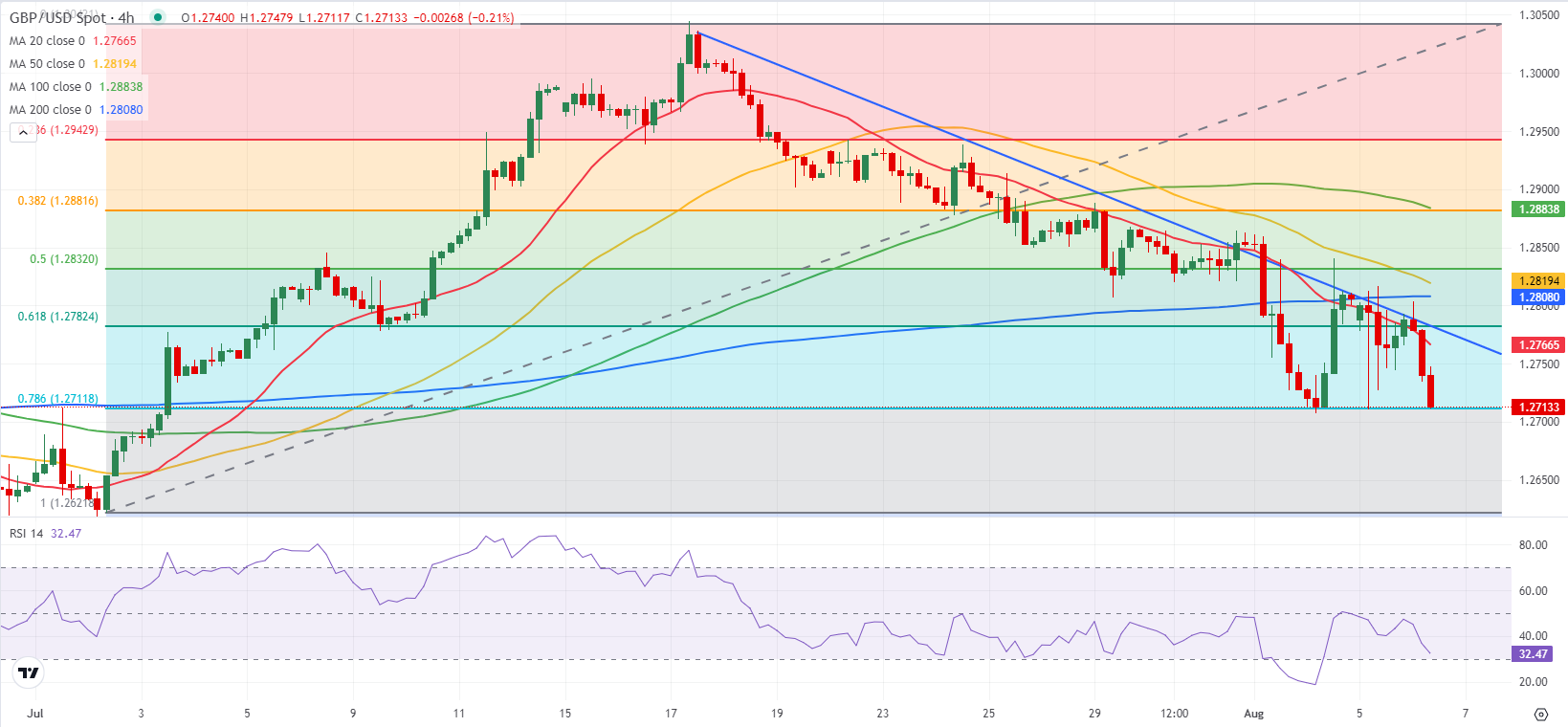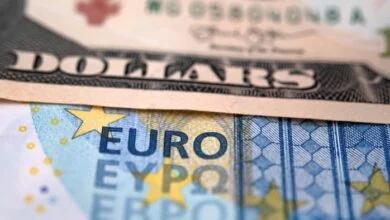Pound Sterling declines toward key support area

- GBP/USD stays under bearish pressure after posting losses on Monday.
- The pair could extend its downtrend if 1.2700 support fails.
- The US economic calendar will not feature any high-impact data releases on Tuesday.
GBP/USD failed to benefit from the broad-based selling pressure surrounding the US Dollar (USD) on Monday and closed the day in negative territory. The pair stays on the back foot early Tuesday and declines toward 1.2700.
British Pound PRICE This week
The table below shows the percentage change of British Pound (GBP) against listed major currencies this week. British Pound was the weakest against the Japanese Yen.
| USD | EUR | GBP | JPY | CAD | AUD | NZD | CHF | |
|---|---|---|---|---|---|---|---|---|
| USD | -0.03% | 0.72% | -1.32% | -0.19% | 0.36% | 0.52% | -0.38% | |
| EUR | 0.03% | 0.67% | -1.44% | -0.29% | 0.38% | 0.44% | -0.46% | |
| GBP | -0.72% | -0.67% | -2.04% | -0.93% | -0.27% | -0.21% | -1.12% | |
| JPY | 1.32% | 1.44% | 2.04% | 1.16% | 1.63% | 1.86% | 0.97% | |
| CAD | 0.19% | 0.29% | 0.93% | -1.16% | 0.58% | 0.71% | -0.37% | |
| AUD | -0.36% | -0.38% | 0.27% | -1.63% | -0.58% | 0.04% | -0.85% | |
| NZD | -0.52% | -0.44% | 0.21% | -1.86% | -0.71% | -0.04% | -0.89% | |
| CHF | 0.38% | 0.46% | 1.12% | -0.97% | 0.37% | 0.85% | 0.89% |
The heat map shows percentage changes of major currencies against each other. The base currency is picked from the left column, while the quote currency is picked from the top row. For example, if you pick the British Pound from the left column and move along the horizontal line to the US Dollar, the percentage change displayed in the box will represent GBP (base)/USD (quote).
Escalating geopolitical tensions triggered an intense flight to safety at the beginning of the week. The broad market selloff weighed heavily on the USD but the risk-sensitive Pound Sterling failed to find demand in the risk-averse market environment.
Although there are no fresh developments that point to a de-escalation of the conflict in the Middle East, investors seem to be breathing a sigh of relief for now. At the time of press, US stock index futures were up between 0.4% and 0.8%, while the UK’s FTSE 100 Index was trading flat. It’s worth noting that US stock index futures were up more than 1% earlier in the session, suggesting that risk flows are losing steam already.
The economic calendar will not offer any high-tier data releases that could impact the USD’s valuation in a meaningful way. Hence, market participants will pay close attention to changes in risk perception.
GBP/USD Technical Analysis
GBP/USD was last seen trading near the 1.2710-1.2700 support area, where the Fibonacci 78.6% retracement of the latest uptrend and a psychological level align. In case that region turns into resistance, additional losses toward 1.2620 (static level, beginning point of the uptrend) and 1.2600 (psychological level, static level) could be seen.
On the upside, resistances could be seen at 1.2780 (Fibonacci 61.8% retracement, descending trend line), 1.2810 (200-period Simple Moving Average) and 1.2830 (Fibonacci 50% retracement).
Pound Sterling FAQs
The Pound Sterling (GBP) is the oldest currency in the world (886 AD) and the official currency of the United Kingdom. It is the fourth most traded unit for foreign exchange (FX) in the world, accounting for 12% of all transactions, averaging $630 billion a day, according to 2022 data. Its key trading pairs are GBP/USD, aka ‘Cable’, which accounts for 11% of FX, GBP/JPY, or the ‘Dragon’ as it is known by traders (3%), and EUR/GBP (2%). The Pound Sterling is issued by the Bank of England (BoE).
The single most important factor influencing the value of the Pound Sterling is monetary policy decided by the Bank of England. The BoE bases its decisions on whether it has achieved its primary goal of “price stability” – a steady inflation rate of around 2%. Its primary tool for achieving this is the adjustment of interest rates. When inflation is too high, the BoE will try to rein it in by raising interest rates, making it more expensive for people and businesses to access credit. This is generally positive for GBP, as higher interest rates make the UK a more attractive place for global investors to park their money. When inflation falls too low it is a sign economic growth is slowing. In this scenario, the BoE will consider lowering interest rates to cheapen credit so businesses will borrow more to invest in growth-generating projects.
Data releases gauge the health of the economy and can impact the value of the Pound Sterling. Indicators such as GDP, Manufacturing and Services PMIs, and employment can all influence the direction of the GBP. A strong economy is good for Sterling. Not only does it attract more foreign investment but it may encourage the BoE to put up interest rates, which will directly strengthen GBP. Otherwise, if economic data is weak, the Pound Sterling is likely to fall.
Another significant data release for the Pound Sterling is the Trade Balance. This indicator measures the difference between what a country earns from its exports and what it spends on imports over a given period. If a country produces highly sought-after exports, its currency will benefit purely from the extra demand created from foreign buyers seeking to purchase these goods. Therefore, a positive net Trade Balance strengthens a currency and vice versa for a negative balance.
Source link






